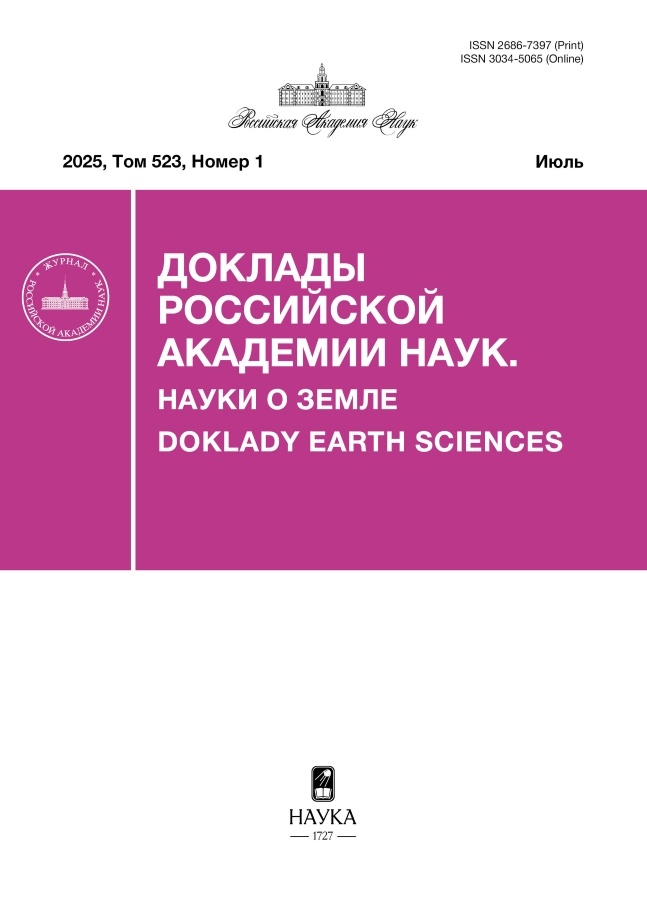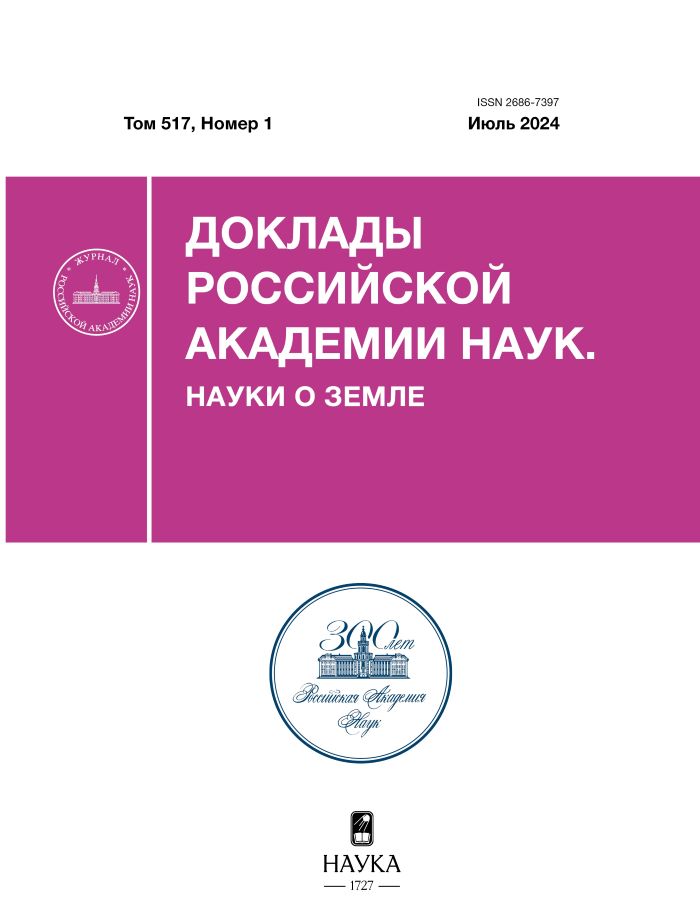Первые результаты изучения сернокислого спелеогенеза в Узбекистане (Средняя Азия)
- Авторы: Базарова Е.П.1, Кадебская О.И.2, Цурихин Е.А.3, Кононов А.М.1,4
-
Учреждения:
- Институт земной коры Сибирского отделения Российской Академии наук
- Горный институт Уральского отделения Российской Академии наук
- ФГУП “Госрыбцентр”
- Иркутский национальный исследовательский технический университет
- Выпуск: Том 517, № 1 (2024)
- Страницы: 171-178
- Раздел: ГЕОГРАФИЯ
- Статья получена: 31.01.2025
- Статья опубликована: 13.12.2024
- URL: https://ter-arkhiv.ru/2686-7397/article/view/650013
- DOI: https://doi.org/10.31857/S2686739724070188
- ID: 650013
Цитировать
Полный текст
Аннотация
На территории Узбекистана исследована пещера, образованная в ходе процесса сернокислого спелеогенеза. Доказательства сернокислого спелеогенеза включают: характерную морфологию подземной полости, широкое развитие восходящих ходов, наличие источника тёплых подземных вод с напорным типом разгрузки и специфическим сероводородным хлоридно-сульфатным натриево-кальциевым химическим составом, присутствие бактериальных матов в водотоках и набор характерных вторичных минералов. По химическому и изотопному составу кислорода и водорода вод источника сделан вывод о том, что подземные воды изученной пещеры являются результатом смешения инфильтрационных пресных вод с седиментогенными водами морского происхождения, а также имеют следы процесса взаимодействия в системе “вода–порода”. Пещера представляет собой пример активного сернокислого спелеогенеза и является первым описанным проявлением сернокислого спелеогенеза в Узбекистане.
Ключевые слова
Полный текст
Об авторах
Е. П. Базарова
Институт земной коры Сибирского отделения Российской Академии наук
Автор, ответственный за переписку.
Email: bazarova@crust.irk.ru
Россия, Иркутск
О. И. Кадебская
Горный институт Уральского отделения Российской Академии наук
Email: bazarova@crust.irk.ru
Россия, Пермь
Е. А. Цурихин
ФГУП “Госрыбцентр”
Email: bazarova@crust.irk.ru
Уральский филиал
Россия, ЕкатеринбургА. М. Кононов
Институт земной коры Сибирского отделения Российской Академии наук; Иркутский национальный исследовательский технический университет
Email: bazarova@crust.irk.ru
Россия, Иркутск; Иркутск
Список литературы
- Palmer A. N., Hill C. A. Sulfuric acid caves // Book chapter in the Encyclopedia of Caves (Second edition). Edited by: W.B. White, D.C. Culver. 2012. 966 p. P. 810–819.
- D`Angeli I. M., Parise M., Vattano M., Madonia G., Galdenzi S., De Waele J. Sulfuric acid caves of Italy: A revier // Geomorphology. 2019. V. 333. P. 105–122.
- Waele J., Audra P., Madonia G., Vattano M., Plan L., D`Angeli I. M., Bigot J.-Y., Nobecourt J. C. Sulfuric acid speleogenesis (SAS) close to the water table: examples from southern France, Austria, and Sicily // Geomorphology. 2016. V. 253. P. 452–467.
- Polyak V. J., Provencio P. By-product materials related to influenced speleogenesis of Carlsbad, Lechuguilla, and other caves of the Guadelupe Mountains, New Mexico // Journal of Cave and Karst Studies. 2001. № 63 (1). P. 23–32.
- Hose L. D., Pisarovicz J. A. Cuevade Villa Luz, Tabasco, Mexico: reconnaissance study of an active sulfur spring cave and ecosystem // Journal of Cave and Karst Studies. 1999. № 61 (1). P. 13–21.
- Puscas C. M., Onac B. P., Tamas T. The mineral assemblage of caves within Salitrari Mountain (Cerna Valley, SW Romania): depositional environment and speleogenetic implications // Carbonates Evaporites. 2010. № 25. P. 107–115.
- Bella P., Bosak P., Mikysek P., Littva J., Hercman H., Pawlak J. Multi-phased hypogene speleogenesis in a marginal horst structure of the Male Karpaty Mountains, Slovakia // International Journal of Speleology. 2019. № 48 (2). P. 203–220.
- Temovski M., Futo I., Turi M., Palcsu L. Sulfur and oxygen isotopes in the gypsum deposits of the Provalata sulfuric acid cave (Macedonia) // Geomorphology. 2018. V. 315. P. 80–90.
- Chervyatsova O. Y., Potapov S. S., Kuzmina L. Y., Dublyansky Y. V., Sadykov S. A., Kiseleva D. V., Okuneva T. G., Dzhabrailov S.-E. M., Samokhin G. V. Sulfuric acid speleogenesis in the North Caucasus: Sharo-Argun valley Caves (Chechen Republic, Russia) // Geomorphology. 2020. V. 369. 107346.
- Гидрогеология СССР. Т. XXXIX. Узбекская ССР / Под ред. Мавлянова Г.А. –М., Недра, 1971. 472 с.
- Кузнецов С. И., Дубинина Г. А. Методы изучения водных микроорганизмов. М.: Наука, 1989. 288 с.
- Egemeier S. J. Cavern development by thermal waters. 1981. National Speleological Society Bulletin. № 43. P. 31–51.
- Galdenzi S. Barite replacement boxwork in the Frasassi caves (Italy) // International Journal of Speleology. 2019. № 48 (3). P. 305–310.
- Polyak V. J., Guven N. Clays in caves of the Guadelupe Mountains, New Mexico // Journal of Cave and Karst Studies. 2000. № 62 (2). P. 120–126.
- Hill C. A., Forti P. Cave Minerals of the World. Huntsville, Alabama, USA: National Speleological Society, 1997. 463 p.
- Жураев М. Р. Уточнение геоструктурных и гидродинамических факторов при формировании сероводородных вод в Сурхандарьинской мегасинклинали // Разведка и охрана недр. 2016. № 4. С. 37–43.
- Craig H. Isotopic variation in meteoric water // Science. 1961. V. 133 (3465). Р. 1702–1703.
- Breitenbach S. F. M., Kwiecien O., Sauro F., Loginov V., Lu Y., Tsurikhin E., Votintseva A. Element and stable isotope aqueous geochemistry from Baysun Tau, Uzbekistan – tracing the source of the dripwater // Proceedings of the 16th International Congress of Speleology. 2013. V. 2. P. 485–488.
- Vlasceanu L., Sarbu S. M., Summers Engel A., Kinkle B. K. Acidic, cave-wall biofilms located in the Frasassi gorge, Italy // Geomicrobiology. 2000. № 17(2). P. 125–139.
- Mansor M., Harouaka K., Gonzales M. S., Macalady J. L., Fantle M. S. Transport-induced spatial patterns of sulfur isotopes (δ34S) as biosignatures // Astrobiology. 2018. № 18. P. 59–72.
Дополнительные файлы















